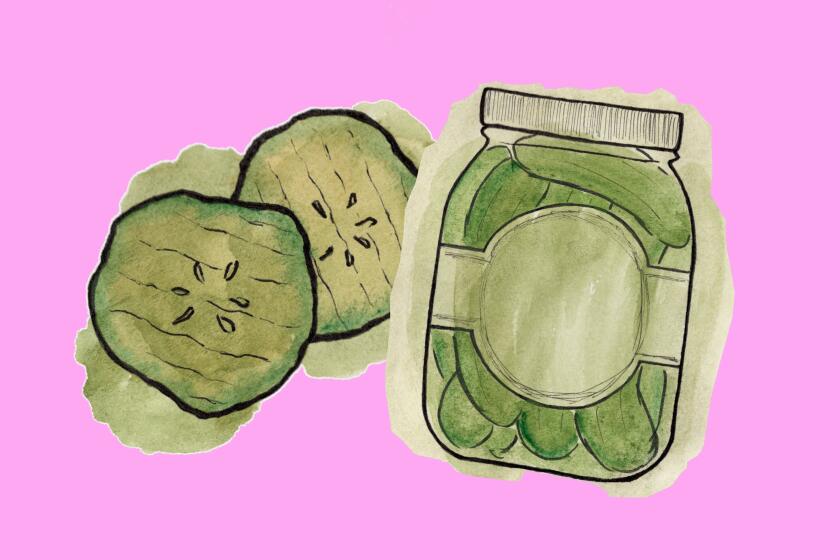Devil in a Red Dress
- Share via
My affair with radishes began only months ago after visiting a friend whose kitchen garden would make even Peter Rabbit’s fastidious Mr. McGregor proud. From somewhere within the neat rows of lettuce, grand artichoke stalks and ambitious tomato vines, my friend pulled up a radish grown plump beneath the soil. A quick rinse, a surprisingly zesty bite, and I immediately began flirting with visions of offering a like treat to my own guests--in my imagination, this would be a testament to my cozy domesticity and clever green thumb.
The seeds are in the ground and I’m coaxing my own crop of those rosy red devils to come forth and flourish. Since radishes--one of the fastest-growing vegetables--take only about three weeks to harvest, and thrive in almost any patch of dirt or container, my earth mother fantasies could be playing out by month’s end. If I replant every couple of weeks, those colorful crops will flavor my meals for months to come.
Despite their reliable reputation as hors d’oeuvres, radishes--or Raphanus sativus--have potential that reaches well beyond the crudites platter. In addition to the distinctive spice and crunch they add to salads and salsas, their peppery flavor and crisp texture holds up when fried, baked or braised. Thought to have originated in Asia thousands of years ago and spread to Europe by the 16th century, radishes today appear in cuisines around the globe. Proof of this abounds in L.A., where they top the fish tacos at Mary Sue Milliken and Susan Feniger’s Border Grill and abound on L’Orangerie’s classic French menu. “We were amazed when we went to Mexico and saw radishes everywhere,” says Milliken. “We use them wherever we can.” Explains L’Orangerie’s Ludovic Lefebvre, who serves cooked black radishes with lobster and yellowtail, “We use radishes a lot in France. It’s a nice combination with fish.”
Other chefs agree. The radish’s sharp flavor enlivens seafood dishes at many of the city’s hot dining spots. They nestle alongside the crab cakes at Vermont and play a supporting role in their version of salad Nioise. At Linq, Andre Guerrero joins cracked pepper and sesame-encrusted tuna with a radish and cucumber salad, while Sushi Roku features an appetizer of salmon wrapped in daikon radish, ponzu and caviar.
For the best selection, and types beyond the familiar crimson globe, cooks head to the farmers’ markets for varieties such as the long white Daikon, an Asian staple, and the equally oversized Black radish. The offering at the Underwood Farm Market stall, which travels to 12 local markets each week, usually includes the thin, pink French Breakfast, the pale White Icicle and their most popular, the fat Easter Egg radish, which is bunched in a mix of white, violet and scarlet. Radishes can be planted year round in our costal climate, but Underwood manager Robbie Denny says the flavor changes with the seasons: “During the summertime radishes are a little spicier, and when it’s cooler, they’re a lot crispier.” If all goes well with my tender seedlings, such nuances will soon be delighting my guests--and confirming my role as an earth mother-in-training.
Braised Red Radishes
Serves 2 as a side dish
20 medium radishes, leaves, stems and rootlets removed (about 1 pound when trimmed)
1 tablespoon unsalted butter
1 medium shallot, minced
1/2 cup chicken or vegetable stock
1 tablespoon honey
Salt
1 tablespoon minced fresh parsley leaves
Unless very small, halve radishes lengthwise from stem to root end. Melt butter in large saute pan. Add shallot and saute over medium heat until softened, about 2 minutes. Add radishes and stir-cook until well coated with butter, about 1 minute.
Add stock and honey, cover and cook until radishes are tender but not soft, about 10 minutes. Remove cover, season with salt to taste and simmer to allow any juices in pan to reduce to glaze, about 1 minute. Garnish with parsley and serve immediately.
Food stylist: Christine Masterson
More to Read
Eat your way across L.A.
Get our weekly Tasting Notes newsletter for reviews, news and more.
You may occasionally receive promotional content from the Los Angeles Times.










